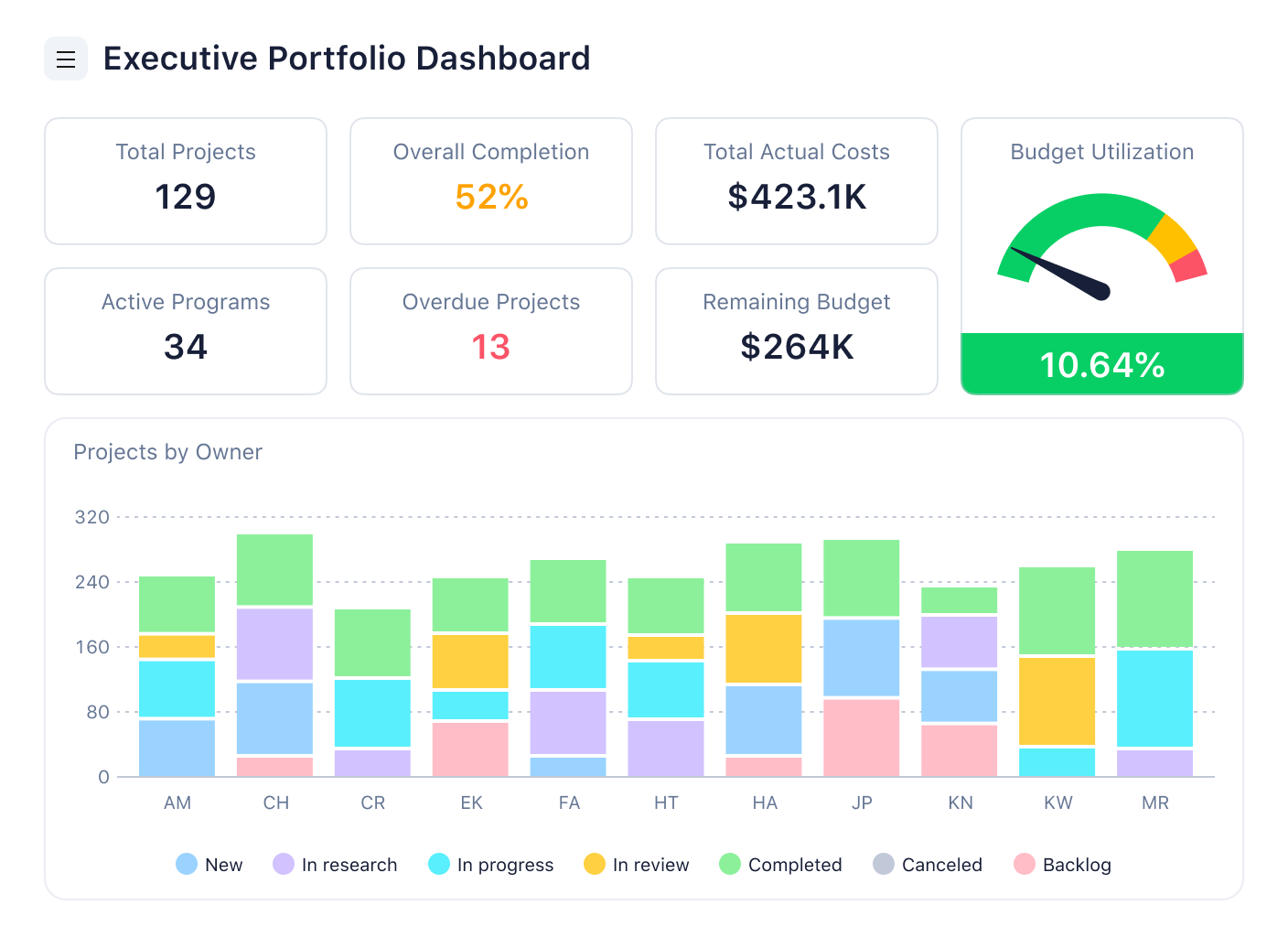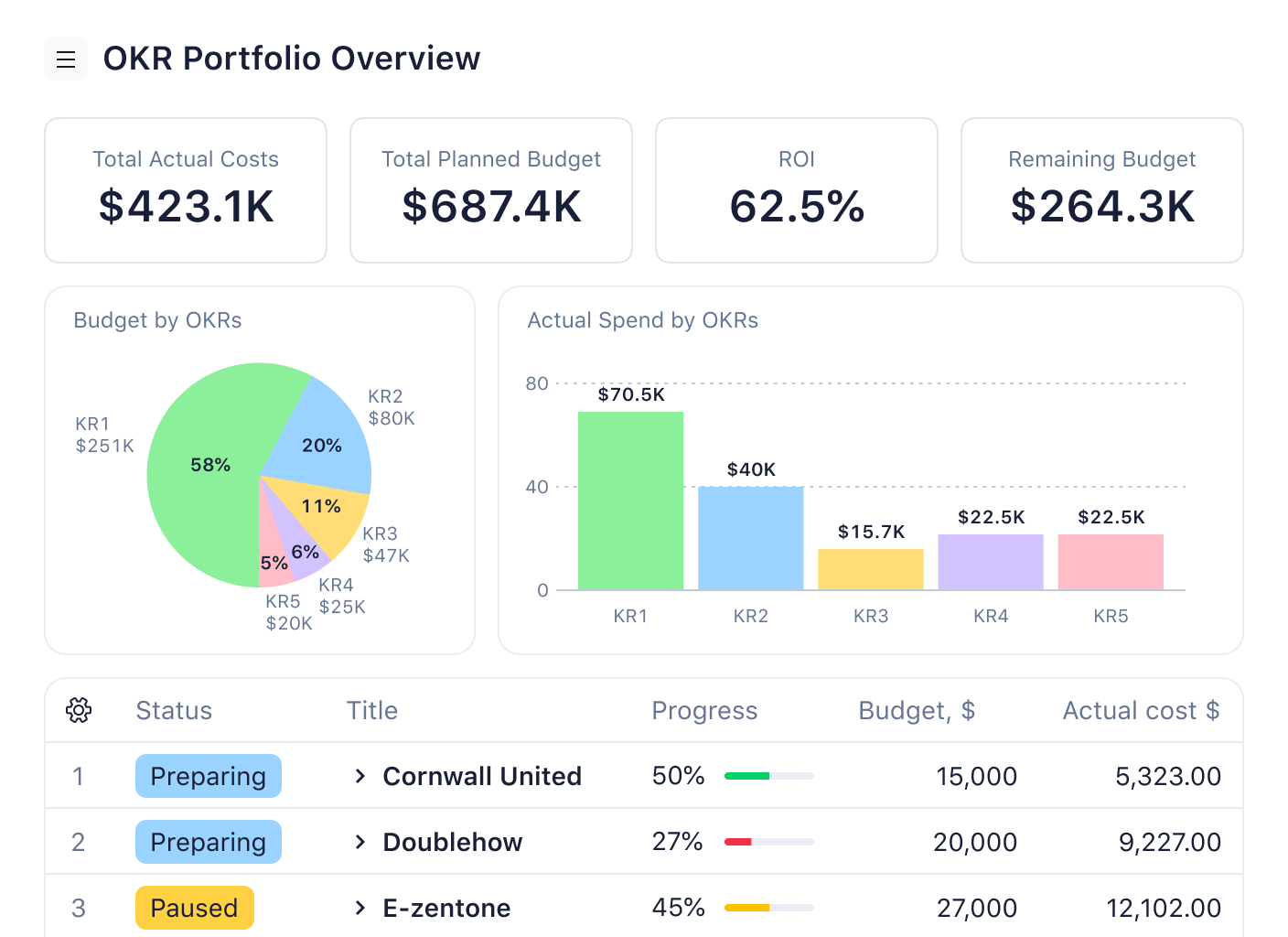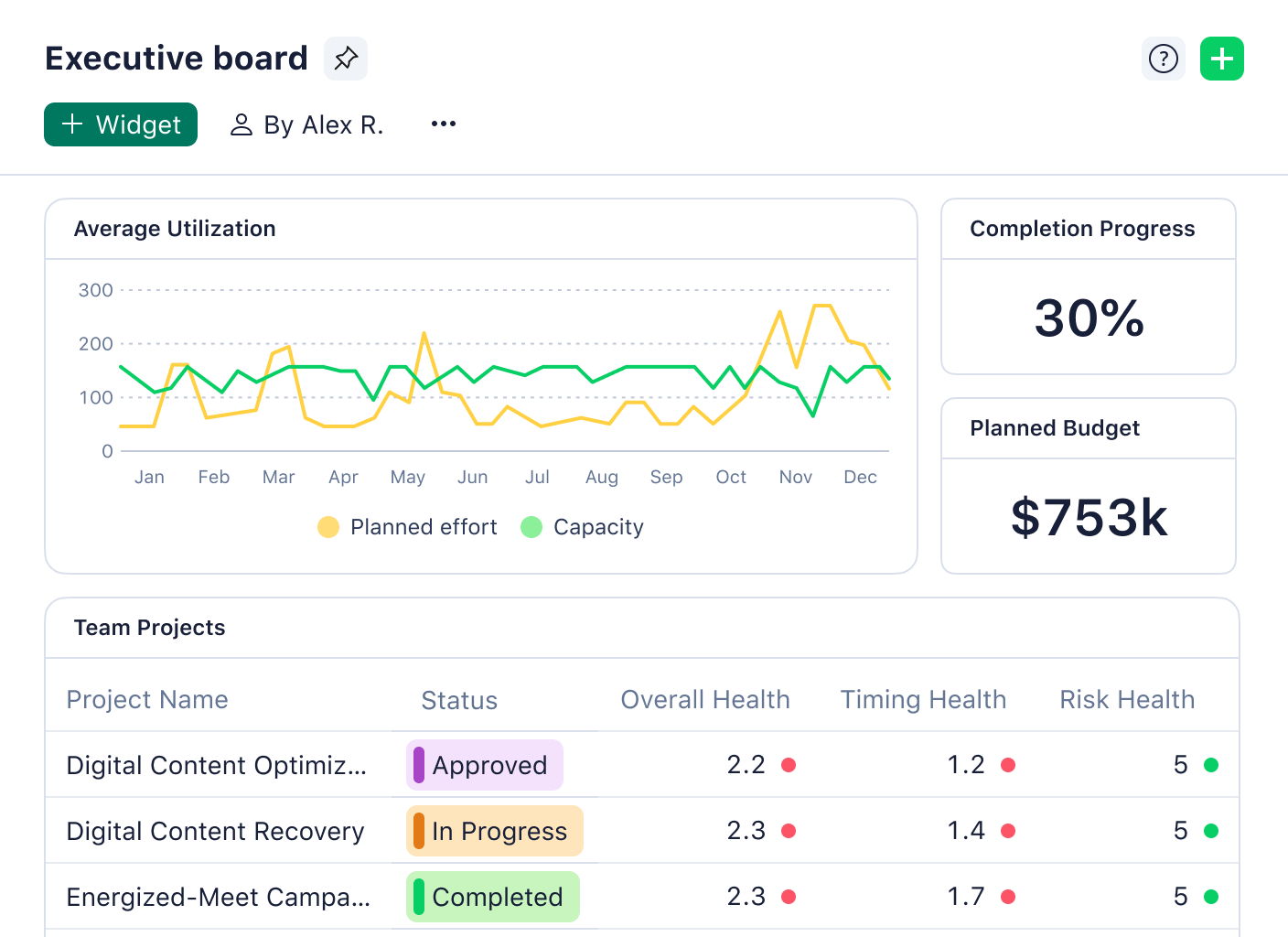What Is a Marketing Dashboard? Guide and Examples

A marketing dashboard is a reporting tool that aggregates key marketing metrics and performance indicators. It presents these data in a clear, single-page view, enabling marketers to monitor progress and adjust strategies efficiently.

To view or create a marketing dashboard of your own, you need to have the right tool in your martech stack. Many comprehensive marketing management software platforms offer dashboard options, as do many free marketing analytics options, like Google Analytics.
In this guide, we will cover what a marketing dashboard is, what benefits it has, how it is used, different types of marketing dashboards, and how to create one using Wrike.
Marketing dashboard examples
Marketing dashboards can be difficult to envision without examples. The selection of marketing dashboard examples below should give you a sense of what you can include in your dashboard and how they can help you visualize your marketing projects and hit your goals.
- Campaign management dashboard: Marketing campaign dashboards will track metrics related to a particular marketing campaign. For instance, a product launch campaign dashboard would include analytics from organic and earned media channels, social media ads, website conversion rates, and other marketing-attributed ROI.
- Digital marketing dashboard: Digital marketing dashboards include website performance, social media analytics, email marketing, ad performance, and revenue.
- SEO dashboard: An SEO dashboard is essential for tracking your website’s search engine performance. It includes metrics such as keyword rankings, organic traffic, and backlink analysis.
- Marketing KPI dashboard: A marketing KPI dashboard tracks key metrics like customer growth, revenue growth, and marketing-attributed ROI.
- Marketing analytics dashboard: This dashboard broadly analyzes your overall marketing efforts. It differs from a marketing metrics dashboard that tracks specific KPIs like conversion rates.
- CMO dashboard: A CMO marketing dashboard gives a visual overview of the key metrics across the company’s marketing activities. This should include lead generation, website performance, social media, and email marketing.


- Email marketing dashboard: Track open rates, click-through rates, and other key email marketing data to gauge the success of your email campaigns.
- Lead generation dashboard: This dashboard tracks the effectiveness of lead generation efforts, providing marketing insights into which channels generate the most leads and how well those leads convert.
What are the benefits of a marketing dashboard?
Why would a marketer create a data dashboard? A marketing dashboard allows marketers of any level to quickly, easily, and succinctly view the metrics and analytics that matter to them. Marketing dashboards save considerable time that marketers would lose if they were switching apps and platforms to view social media analytics, website analytics, or campaign metrics separately.
Marketing dashboards also allow members of a marketing team to view key performance metrics (KPIs) and campaign data in real time. This is especially important for managers, who need to track the marketing campaign’s success and make quick decisions to adjust marketing tactics or reallocate resources depending on the relative success of one metric or channel over another.
These tools are easily customizable, allowing marketers to monitor unique metrics on different campaigns without hassle. Managers can personalize their dashboards, reporting functionality, and regularity, allowing them to tailor the data to specific needs and communicate with stakeholders as quickly as needed.
Marketing dashboards typically use data visualization tools, such as charts and graphs, which make it easier to understand complex data and identify patterns.
What problems can a marketing dashboard alleviate?
When used correctly, marketing dashboards can alleviate a range of problems your marketing team might face, from siloed communication to misunderstanding customer behavior. Here are a few ways a marketing dashboard can supercharge your marketing department:
- Enhanced visibility: Marketing dashboards greatly enhance a marketer’s ability to see the status of their team’s and their own activities without having to spend time checking in with individual team members.
- Increased efficiency: Generating reports and viewing metrics in different platforms sucks up time from any marketer’s busy schedule. A marketing dashboard cuts out that inefficiency, displaying metrics from different channels in the same place for easy viewing.
- Real-time customer data: Marketing dashboards update constantly, giving marketers a real-time view of customer behavior, website traffic, and even lead generation status.
- Better decision making and forecasting: Having swathes of data at hand and easy to view makes decision making and forecasting faster and simpler. Managers or CMOs are able to drill down into finer details or get a broad sense of various metrics, informing decisions that can move the team toward achieving department-wide goals.
- Enhanced KPI monitoring: Keeping KPIs front and center can greatly improve how well they’re met across the entire marketing team. Additionally, marketing dashboards can help marketers get a better understanding of bottlenecks or problems that could be preventing them from reaching KPIs.
How is a marketing dashboard used?
Members of the marketing team will use marketing dashboards in different ways. How each member uses a marketing dashboard varies depending on the metrics they track. Some team members need to keep a near-constant eye on the metrics they’re following, while others use a marketing dashboard to get a weekly or monthly sense of campaign or project success.
Marketers can set up bespoke and customized dashboards that incorporate the data they need to see on a regular basis. For instance, a social media specialist would set up a marketing dashboard that could provide analytics produced from an ongoing social media campaign.
Viewing engagement and click-through rates and sharing the data with team members can help a social media marketer realistically assess the success of a particular campaign performance and adjust strategy preemptively if the campaign is heading for a stumbling block.
Who typically uses a marketing dashboard?
As seen in the examples at the start of this guide, many different members of the marketing department can and should use marketing dashboards.
- Chief marketing officer (CMO): A CMO would use a marketing dashboard to pull in various forms of data to get a clear picture of the success of the organization’s entire marketing operation. These insights would help them lead the overall strategic direction of the organization’s marketing efforts. They would benefit from a marketing dashboard tool that provides a high-level overview of key metrics across marketing channels and helps identify anomalies, outliers, or areas for improvement to optimize the company’s marketing efforts.


- Marketing project manager: A marketing project manager would benefit from a marketing dashboard tool that provides detailed metrics on project progress. This would help them identify any upcoming risks, schedule conflicts, or resource scarcity and plan proactively to mitigate them. A marketing dashboard empowers marketing project managers to identify star players in their teams, note each member’s strengths, and work with them in the best ways to get the best results and deliver successful marketing projects.

- Marketing analyst: A marketing analyst is responsible for analyzing marketing performance data and providing insights to inform and improve the current marketing strategies. Analysts would benefit from using unified marketing dashboard tools that provide relevant, curated metrics aligned with the organization’s goals.
- Search engine optimization (SEO) manager: An SEO manager is responsible for improving a company’s search engine rankings and online visibility. These marketing professionals would benefit from a dashboard tool that provides drilled-down metrics on website traffic, search engine rankings, and backlink analysis. This would help them identify opportunities for improvement and optimize their SEO efforts to achieve set goals.
- Digital marketing manager: Digital marketers use marketing dashboards to track metrics and measure their performance against the assigned goals and metrics they are responsible for. This may include website management, social media, email marketing, and PPC or online advertising.
What should a marketing dashboard include?
A marketing dashboard should include any and all metrics a marketer needs to view to better understand and reach their own KPIs, or to track the work within their remit. A marketing dashboard would typically include a selection of the following:
- Website performance: From bounce rates to time on site, a digital marketing dashboard usually includes website performance analytics.
- Traffic sources: You’ll especially want to track the traffic sources driving visitors to your website, including social media, organic search, and paid advertising.
- Social media metrics: Instead of focusing solely on social media follower numbers, make sure you have a dashboard widget for tracking the effectiveness of calls to action (CTAs).
- Conversion funnel: Most dashboards, including Wrike, include a conversion funnel with data pulled from a platform like Salesforce that can track leads, opportunities, and wins.
- Digital ad information: Digital marketers can track paid search engine advertising campaigns, and view the data in real time. This allows marketers to pick up on trends or successful ads in order to optimize them.
- Email marketing information: Marketing dashboards can also include email marketing information, including open, click, and unsubscribe rates.
Marketing dashboard tools
Marketing dashboards can make all the difference in how teams and individual marketers operate. Crucial insights can convey how successful the marketing department is at reaching weekly, monthly, and yearly goals. The right marketing dashboard tool should be easy for any marketer to use and easily customizable with various metric tracking views.
All team members can work from a centralized location, using up-to-date and synchronized data to derive insights and identify opportunities to make positive data-driven decisions. Marketing dashboard tools automate this data collection and analysis, saving marketers significant time and effort and freeing up room for other high-value tasks.
It’s worth mentioning that the best marketing dashboard tools integrate easily with content publishing, social media automation, and scheduling tools, allowing in-house and remote marketing teams to plan campaigns collaboratively months or weeks in advance. This is extremely useful for teams with a lengthy review process, enabling them to complete their approval workflows and maintain consistency in creative asset branding and messaging throughout multiple marketing projects.
Overall, marketing dashboard tools are a valuable asset for any marketing team, as they provide a wealth of data that can be used to inform and improve marketing strategies and position the business to optimize opportunities.
Wrike offers various marketing dashboard templates to create your own highly functional marketing dashboard. Wrike dashboards allow you to view campaign details at a granular level, analyze team and campaign productivity, and view live updates at a glance.
How to create a marketing dashboard
How do you build a marketing dashboard that really works for you? It’s a common question for many marketers who want to get the most out of their data. Let’s consider the steps involved in creating a marketing dashboard:
Step 1: Define your objectives
What do you want your marketing dashboard to do for you? This is the first question you should ask yourself.
- Do you need to track the effectiveness of your digital marketing campaigns?
- Do you want to build a marketing funnel?
- Do you want to track data from Google Analytics?
By determining your marketing objectives, you can decide which key metrics to include in your dashboard. While marketing analytics and metrics help marketers understand their target market, campaign success metrics, and customer relationship management nuances, it’s also important to visualize these numbers.
That’s where your marketing dashboard comes in — it helps you bring all this valuable data together in one place.
Step 2: Choose the right tools
Instead of digging through spreadsheets or opening up a host of apps and platforms to view each marketing metric individually, you’ll want to turn to a marketing dashboard to streamline, process, and derive insights from your unified marketing analytics data.
Step 3: Design your dashboard layout
Start by grouping similar metrics. For example, you could put all your social media marketing data in one section. And don’t forget about visual aids — charts, graphs, and other visuals can make your data much easier to digest at a glance.
Step 4: Customize and review
Now that your dashboard is up and running, what’s next? It’s time to truly make it your own. Customize it to fit your specific needs by adding new widgets, tweaking the layout, or pulling in more data sources. And remember, your dashboard isn’t set in stone — regularly review and refine it to ensure it continues to deliver valuable insights that align with your marketing goals.
Create a marketing dashboard with Wrike
Wrike’s marketing dashboards gather everything teams need to succeed in one place. This includes plans, assignments, progress, analytics, and more. Marketers can deliver successful marketing campaigns with effortless cross-team collaboration, using Wrike as a single marketing management platform with secure and shared dashboards for campaign management, document and asset production, and performance insights.
Creating a marketing dashboard with Wrike is simple to do. Follow the steps below, and you’re well on your way to managing your marketing projects visually and with a clear structure.
There are two ways to begin creating a marketing dashboard in Wrike:
- From the Home page or the More menu
- From the Tools options in Spaces
From the Home page or the More menu
- Click Dashboards in the menu on your Home page.
- In the top right-hand corner, click your chosen dashboard’s name. If you don’t have any dashboards yet, click Create Dashboard and select + New Dashboard from the bottom of the drop-down menu.
- Enter a name for your new dashboard and specify the space it should belong to. The new dashboard will appear in the Tools section of the space it belongs to.
From the Tools options in Spaces

- Navigate to the space where you wish to create the dashboard and hover over Tools in the left-hand menu.
- Click the + icon that appears and select Dashboard in the drop-down menu that appears.
- Enter a name for your new dashboard and specify the space it should belong to. You’ll be taken to your new dashboard, where you can begin to create and add relevant widgets.
That’s all you need to know to begin creating a marketing dashboard for your marketing team’s needs. Whether working on only one organization’s marketing campaigns or managing multiple brands and shifting KPIs, using a personalized marketing dashboard empowers you to see and accomplish more in less time.
Are you ready to create a marketing dashboard that puts your organization’s goals and metrics front and center? Get started with a two-week free trial of Wrike today.

